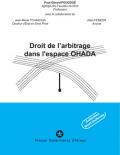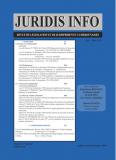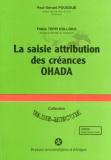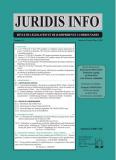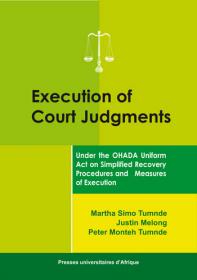
Execution of Court Judgments
An authoritative introduction to the law relating to the execution of court judgments in the seventeen member States of the Organisation for the Harmonisation of Business Law in Africa (OHADA) A panoramic view of the OHADA Uniform Act on Simplified Recovery Procedures and Measures of Execution Explains the background, critically examines the current laws with abundant ca
| Détails sur le livre | |
|---|---|
| Auteur | Martha Simo Tumnde, Justin Melong, Peter Monteh Tumnde |
| ISBN | 9956-444-70-7 |
| Nombre de pages de la version papier | 256 pages |
| Format | Papier 170 x 250 mm |
| Date de publication | 2013 |
| Editeur | Presses universitaires d'Afrique |
| Langue | Anglais |
An authoritative introduction to the law relating to the execution of court judgments in the seventeen member States of the Organisation for the Harmonisation of Business Law in Africa (OHADA) A panoramic view of the OHADA Uniform Act on Simplified Recovery Procedures and Measures of Execution Explains the background, critically examines the current laws with abundant cases and assesses the prospects for the future Makes sound recommendations for improvements of the execution regime put in place by OHADA Written for both Common Law and Civil Law trained legal practitioners, bailiffs, magistrates, law researchers and law students Authors are seasoned academicians, law trainers, expert legal translators and senior advocates with hands-on experience in the OHADA territories.
The Organization for the Harmonization of Business Law in Africa, known by its French acronym, OHADA, is a system of business-related laws, designed to reduce transaction costs, promote transparency and predictability in business ventures. Its laws are directly applicable in 17 countries with more than 250 million people. The promulgation in 2010 of a law on the accession of the Democratic Republic of Congo to the OHADA Treaty followed by the deposition of ratification instruments is further proof of Africa’s determination to improve investment climate and reassure investors. There is therefore clearly a dynamic trend toward harmonisation of applicable business laws in Africa spearheaded by OHADA.
Regrettably, adequate implementation of OHADA laws in member States remains the issue of concern, especially in Common Law jurisdictions. The main objective of this book is therefore to raise and discuss relevant issues that impede the smooth implementation of these laws. The intention of the authors is to familiarise practitioners and other stakeholders with the execution regime put in place by OHADA and to contribute towards promoting investment, economic growth and social development.
Dedication
Table of contents
Table of cases
List of statutes
Abbreviations xx
About the Authors
Foreword
Preface
Chapter One: General Introduction
Chapter Two: Panoramic View of the Ohada Uniform Act Organising Simplified Recovery Procedures and Measures of Execution
II.0) Introduction
II.1) Simplified Recovery Procedures
II.1.1) Injunction to Pay
II.1.1.1) Conditions for Injunction to Pay
II.1.1.2) Procedure for Injunction to Pay
II.1.1.3) Jurisdiction of the Court
II.1.2) Injunction to Deliver or to Return an Object
II.1.2.1) Conditions for an Injunction to Deliver or to Return
II.1.2.2) Procedure and Jurisdiction of the Court
II.2) Enforcement Measures
II.2.1 Provisional or Conservatory Measures (Saisies conservatoires)
II.2.1.1) Conditions for Granting a Conservatory Measure
II.2.1.2) Procedure for Obtaining a Conservatory Measure
II.2.1.2.1) Seizure of Tangible Assets
II.2.1.2.2) Seizure of Debts owed to the Debtor
II.2.1.3) Seizure of Transferable Securities and other Partnership Rights or Shareholdings
II.2.2) Measures of Execution stricto sensu
II.2.2 .1) Seizure for Sale of Tangible Goods
II.2.2.1.1) Conditions for Sale of Tangible Goods
II.2.2.1.2) Procedure relating to the Seizure for Sale of Tangible Goods
II.2.2.1.3) The Sale of Seized Assets
II.2.2.2) Seizure of Standing Crops
II.2.2.3) Seizure-Awards of Claims or Garnishee Proceedings
II.2.2.4) Seizure-Assignment of Wages and Salaries
II.2.2.5) Execution of Claims of Alimony
II.2.2.6) Seizure-Apprehension and Seizure under a Prior Claim of Tangible Property
II.2.2.7) Seizure of Transferable Securities and Partnership Rights
II.2.2.8) Attachment and Sale of Real Property (saisie immobilière)
II.2.2.8.1) Conditions for the Seizure of Real Property
II.2.2.8.2) Procedure for Seizure and Sale of Immovable Assets.
II.3) Conclusion
Chapter Three: Difficulties of Implementing the OHADA Law on Execution
III.0) Introduction
III.1) Interpretation Difficulties
III.1.1) The Role of the CCJA in ensuring Uniform Interpretation
III.1.2) Rules of Interpretation in Civil Law and Common Law Jurisdictions
III.2) Problems arising from Provisional Execution by virtue of Article 32
III.3) Problems raised by the Requirement of Conciliation in an Injunction to Pay Procedure
III.4) The Requirement of Prior Summons to Pay in a Seizure for Sale of Tangible Property
III.5) Distrainee made Custodian of the Seized Assets
III.6) Execution and Incidence of Procedure: The Case of the Attachment and Sale of Real Property
III.6.1) Incidence arising from Multiple Seizures
III.6.2) Petition for Diversion
III.6.3) Petition for Nullity of Seizure
III.6.4) Incidence Relating to Irresponsible Bidding
III.6.5) Incidence in Relation to the Distribution of Proceeds of Sale
III.7) Immunity from Execution
III.7.1) Recent Trends in the Application of Immunity in Cameroon
III.7.2) The Way Forward
III.8) Seizure of Assets in the Hands of a Third Party
III.9) Professional Misconduct Displayed by some Actors of Execution
III.9.1) Illegal Dealing with Debtors to Frustrate Seizure Operations
III.9.2) Overbilling of Seizure Operations
III.9.3) Fictitious Notifications
III-10) Corruption, Judicial Bottlenecks and Inefficiency
III.11) Delay, Complexity and High Cost of Execution
IV. Conclusion
Chapter Four: Difficulties of Implementation in a Bijural and Bilingual Context: The Case of Cameroon
IV.0) Introduction
IV.1) Genesis of the Problem
IV.2) Challenges of Legal Translation
IV.2.1) Nature of Legal Language
IV.2.1.1) Legal Vocabulary
IV.2.1.2) Stylistic Features of Legal Language
IV.2.1.3) Syntactical Features of Legal Language
IV.2.1.4) Semantic Features of Legal Language
IV.2.2) Terminological Issues
IV.2.3) Other relevant Translation Techniques in Legal Translation
IV.2.3.1) Using Source Language (SL) Terms or Concepts in their Original Form:The Purist Approach
IV.2.3.2) Using Neutral Terms accompanied sometimes by Definition for additional clarification or original term in bracket
IV.2.3.3) Borrowing
IV.2.3.4) Neologism
IV.2.3.5) Defining and Paraphrasing
IV.3) Discussion of some Theoretical Issues in Legal Translation
IV.4) Some Thoughts about Harmonizing Legal Practice in Civil Law and Common Law Jurisdictions of Cameroon
IV.5) Conclusion
Chapter Five: Conclusion and Recommendations
V.1) Ensuring Transparency and Foreseeability of Execution Costs
V.2) Training and Continuing Training of Bailiffs and Enforcement
Agents
V.3) The Need to draft Quality Standards on Enforcement Measures
V.4) Working Towards Improving the Indicators of Efficiency
V.5) Access to Information About Assets
V.6) The Need to further Narrow the Gap between the Civil Law and the Common Law .
BIBLIOGRAPHY .
APPENDICES
Appendix I: Petition for Injunction to Pay in theCourt of First Instance of Limbe .
Appendix II: Injunction to Pay
Appendix III: Opposition to an Injunction to Pay
Appendix IV: Conciliation/Hearing Notice
Appendix V: Conciliation Report
Appendix VI: Notification of an Injunction to Pay
Appendix VII: Report of Seizure for Sale
Appendix VIII: Report of Taking Possession of the property (P.V. de Recollement).
Appendix IX: OHADA Uniform Act Organising Simplified Recovery Procedures and Measures of Execution
INDEX


